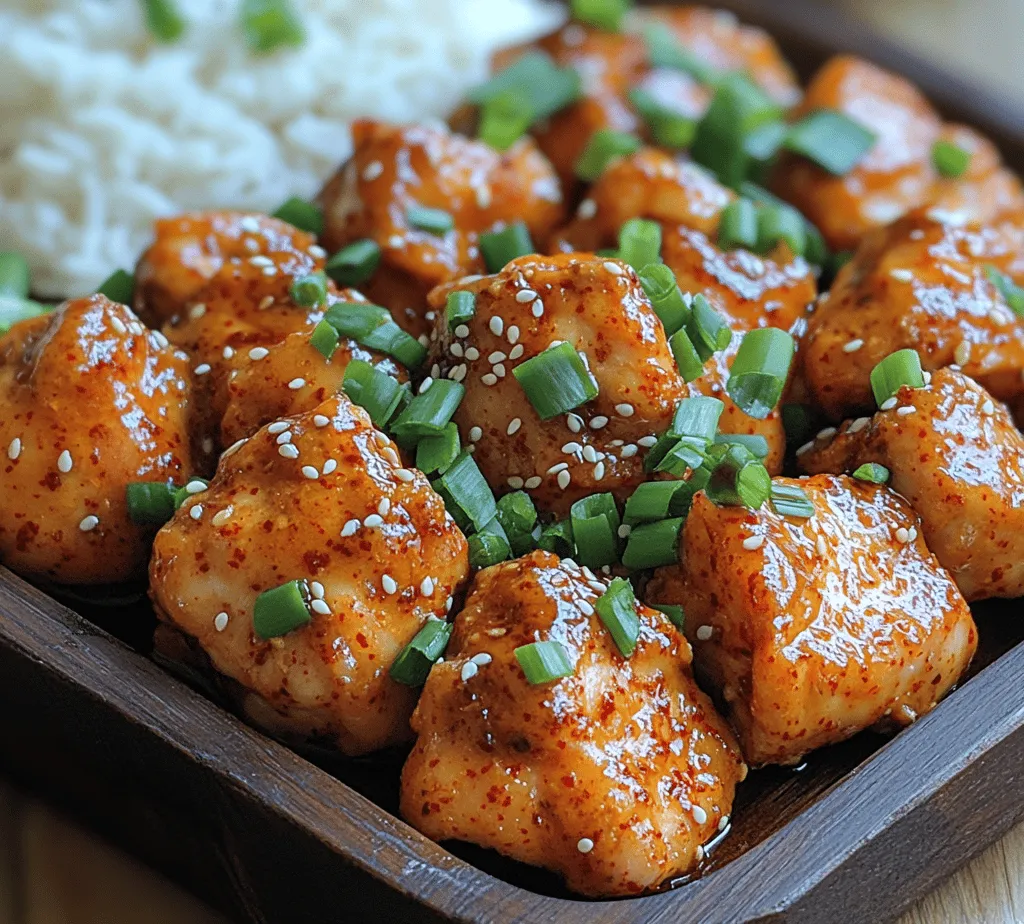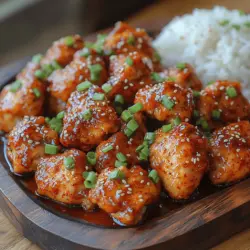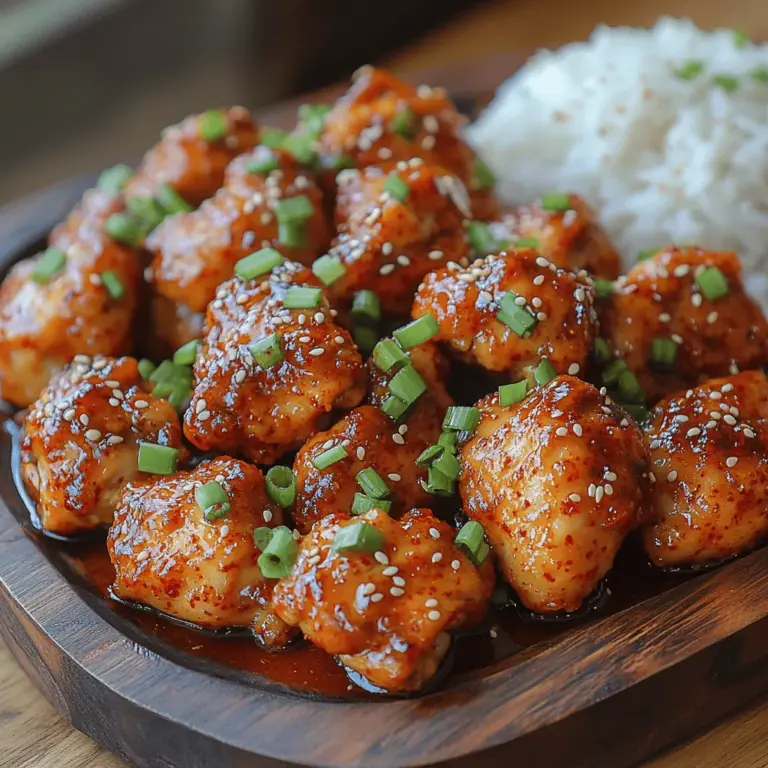Introduction
Korean cuisine has garnered immense popularity around the globe, celebrated not only for its bold flavors but also for its health benefits and vibrant presentation. At the heart of many traditional Korean dishes is gochujang, a fermented chili paste that brings a unique depth of flavor, characterized by its spicy, sweet, and savory notes. This iconic condiment is a staple in Korean kitchens and has found its way into the hearts and homes of food lovers everywhere.
One dish that perfectly showcases the versatility and deliciousness of gochujang is Spicy Gochujang Chicken. This flavorful, easy-to-make recipe combines tender chicken thighs with the rich, complex flavors of gochujang, creating a dish that is both satisfying and exciting for the taste buds. The balance of spice, sweetness, and umami makes Spicy Gochujang Chicken a standout option for weeknight dinners or when you’re in the mood for something different yet comforting.
In this article, we will explore the background of gochujang, its nutritional benefits, and how to choose the best quality for your cooking needs. We will also break down the ingredients used in our Spicy Gochujang Chicken recipe and guide you through the initial steps to create this delectable dish.
Understanding Gochujang
Gochujang is a traditional Korean condiment made from red chili powder, glutinous rice, fermented soybeans, and salt. This unique fermentation process gives gochujang its distinctive flavor profile, which is both spicy and sweet. It plays a crucial role in Korean cooking, used not only as a seasoning but also as a base for marinades, sauces, and soups. The versatility of gochujang means it can be adapted to various dishes, enhancing everything from stews to grilled meats.
Nutritional Benefits of Gochujang
Beyond its robust flavor, gochujang also offers several nutritional benefits. It is low in calories and contains essential nutrients such as vitamins A, C, and B, along with potassium and dietary fiber. The fermentation process contributes to gut health, as it contains probiotics that promote a healthy digestive system. Additionally, the chili peppers used in gochujang are packed with antioxidants and can help boost metabolism, making it a smart addition to your culinary repertoire.
How to Choose Quality Gochujang
When selecting gochujang for your recipes, it’s essential to choose a high-quality product to ensure the best flavor and health benefits. Look for gochujang that is made with natural ingredients and does not contain artificial preservatives or excessive sugar. You can typically find gochujang in Asian grocery stores or the international aisle of larger supermarkets. Different brands may have varying heat levels, so if you’re sensitive to spice, consider starting with a milder version and adjusting according to your taste preferences.
Ingredients Breakdown
To create the perfect Spicy Gochujang Chicken, a careful selection of ingredients is required. Here’s a detailed overview of each component that brings this dish to life:
Chicken Thighs
For this recipe, boneless and skinless chicken thighs are ideal. They are more flavorful and tender compared to chicken breasts, making them perfect for marinating. The thighs hold up well during cooking, ensuring a juicy and satisfying bite in every piece.
Gochujang
As the star ingredient, gochujang adds a complex flavor that is both spicy and sweet. There are various varieties available, ranging from mild to hot, so be sure to choose one that suits your heat tolerance. The richness of gochujang will make for a deeply flavored sauce that clings beautifully to the chicken.
Soy Sauce
Low-sodium soy sauce is the best choice for this recipe. It adds a savory depth to the marinade without overwhelming the dish with saltiness. The umami notes from the soy sauce complement the sweetness of gochujang and the other ingredients, enhancing the overall flavor profile.
Honey
Incorporating honey into the marinade is crucial as it balances the spiciness of the gochujang. The sweetness of honey not only complements the heat but also helps in caramelizing the chicken during cooking, resulting in a beautiful glaze.
Sesame Oil
A small amount of sesame oil adds a nutty richness to the dish. It enhances the flavor and aroma, making the chicken even more enticing. Additionally, sesame oil contains healthy fats and antioxidants, contributing to the overall health benefits of this recipe.
Garlic and Ginger
The addition of garlic and ginger provides aromatic complexity to the marinade. Both ingredients are staples in Asian cuisine, known for their health benefits, including anti-inflammatory properties. Their bold flavors help create a well-rounded taste that elevates the chicken.
Rice Vinegar
A splash of rice vinegar adds acidity to the marinade, which is essential for balancing flavors. The tanginess of rice vinegar cuts through the richness of the chicken and the sweetness of the honey, creating a harmonious blend of taste.
Vegetable Oil
For frying the chicken, vegetable oil is recommended due to its high smoke point. This ensures that the chicken cooks evenly and achieves a crispy texture. You can also use oils such as canola or peanut oil if preferred.
Cornstarch
Cornstarch is a secret ingredient that helps create a crispy texture on the chicken. When coated lightly before frying, it forms a lovely crust that enhances the dish’s mouthfeel and makes it even more enjoyable.
Garnishes
Finally, green onions and sesame seeds serve as garnishes that not only add a pop of color but also provide an extra layer of flavor and texture. The fresh crunch of green onions and the nutty seeds create an appealing presentation and enhance the overall eating experience.
Step-by-Step Cooking Instructions
Marinating the Chicken
Marination is a crucial step in preparing Spicy Gochujang Chicken, as it allows the flavors to penetrate the meat, resulting in a more flavorful and tender dish.
1. Prepare the Marinade: In a medium mixing bowl, combine the gochujang, low-sodium soy sauce, honey, sesame oil, minced garlic, grated ginger, and rice vinegar. Whisk the ingredients together until well blended, creating a smooth marinade.
2. Marinate the Chicken: Place the boneless, skinless chicken thighs in a large resealable plastic bag or a shallow dish. Pour the marinade over the chicken, ensuring that each piece is evenly coated. Seal the bag or cover the dish tightly, and refrigerate for at least 30 minutes. For best results, allow the chicken to marinate for 2 to 4 hours, or even overnight if time permits. This will deepen the flavors and enhance the overall taste of the dish.
3. Prepare for Cooking: Once the chicken has marinated, remove it from the refrigerator. Let it sit at room temperature for about 15 minutes before cooking. This helps the chicken cook more evenly.
With the marination complete, you are now ready to move on to the cooking process, where the magic truly happens. Stay tuned for the next part of this article, where we will discuss the frying technique and how to serve this delicious Spicy Gochujang Chicken to impress your family and friends.


